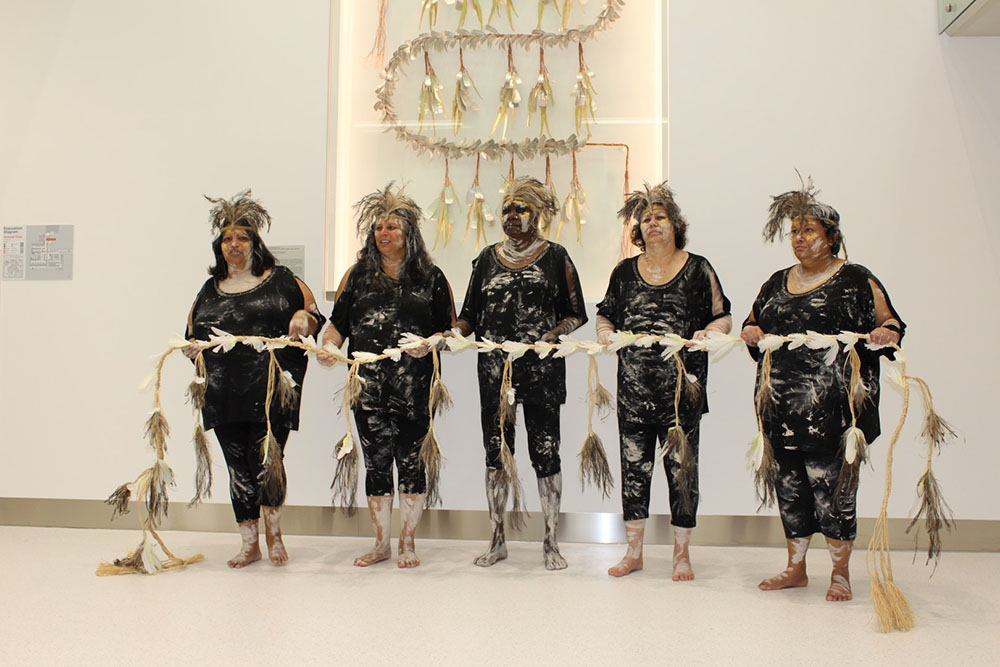Art plays a pivotal role in providing patients and communities with positive experiences in health facilities, making what can be the most stressful times in people’s lives more welcoming and inclusive. Health Infrastructure Chief Executive Rebecca Wark shares how art is considered and incorporated in health infrastructure projects to foster better health and wellbeing outcomes.
Health Infrastructure is a NSW Health statewide service, delivering infrastructure solutions and services to support the healthcare needs of NSW communities.
Art strategy is a key component of our projects as we work closely with local health districts (LHDs), pillars and networks to oversee the planning, design and construction of major health capital works in NSW.
We know that exposure to the arts has a profoundly beneficial impact, improving patient, staff and visitor wellbeing, and improving health literacy for individuals and the wider community through its use in health promotion and messaging.
Health Infrastructure’s Arts in Health Program is guided by the NSW Health and the Arts Framework and overseen by an Arts Advisory Panel, which was established in 2018 to maximise opportunities to include arts initiatives in major capital projects. The Panel consists of highly respected art and health sector leaders including Deputy Secretary, Clinical Innovation and Research and Chief Executive, ACI, Jean-Frédéric Levesque, LHD and Ministry of Health representatives as well as patient advocate and award-winning musician Luke Escombe.
Since the Panel’s inception, triple the number of arts projects have been commissioned for NSW Health at a third of the previous cost of delivery, achieving better value for NSW. Stronger engagement with professional art sector leaders and artists is driving substantively improved community and clinical co-design outcomes.
With guidance from the Panel, Health Infrastructure has adopted a co-design approach for determining Arts in Health initiatives. This requires intense collaboration with and listening to communities, Aboriginal Elders and clinicians to understand their aspirations for community wellness. It’s an approach that also ensures arts initiatives align with the Future Health Strategy, celebrate local characteristics valued by community, respect heritage and foster inclusion, creativity, enterprise and clinical innovation.
Highlighted below are two projects that demonstrate the success of the Arts in Health Program and the approaches used by Health Infrastructure.
Dubbo Hospital redevelopment

Collaborating with the community, Aunty Diane McNaboe and Wiradjuri/Gamilaroi artist Jonathan Jones created a traditional women’s dance belt several metres in length, which was framed for the main entry of the maternity unit. Made of emu feather and copper wire, the work is said to be the first known belt created in the region for generations. In the first 12 months after installation, Dubbo Hospital experienced a 27% increase in the number of Aboriginal women seeking antenatal care before they went into active labour.
More about the Dubbo Hospital redevelopment
Murrumbidgee Multipurpose Service (MPS)

Inspired by the ACI’s Living well in MPS Strategy, Health Infrastructure brokered a partnership between the Murrumbidgee LHD and the Art Gallery of NSW. Based on a decade of dementia research, the program provides a non-pharmacological approach to care, co-designed and delivered with consumers at the LHD’s Murrumburrah-Harden Health Service, and Culcairn and Tumbarumba MPS.
The program involves a rotating exhibition of 60 framed reproduction prints from the Gallery’s collection, supported by resources for residents, staff and local schools to connect more meaningfully with each other.
As an effective, low-cost program, it directly contributes to key objectives of the Future Health Strategy, notably driving value-based healthcare. Learn more about the MPS Arts in Health Program.
Two other art projects Health Infrastructure is particularly proud of includes those for the Macksville Hospital redevelopment and the Goulburn Base Hospital redevelopment.
These are just a few of the many arts projects being delivered by Health Infrastructure in partnership with artists, clinicians and community across NSW.
Collectively, they are a testament to NSW Health, Health Infrastructure and the Arts Advisory Panel’s passion and commitment to engaging the arts as a tool to humanise healthcare settings and deliver person-centred care.
About Rebecca Wark
 Having joined Health Infrastructure in 2008, Rebecca has progressed through various senior roles to take up the reins of Chief Executive. Previously Executive Director of Rural and Regional projects, she spent many years working in country areas to deliver critical health infrastructure, overseeing the NSW Government’s record investment in regional health. Rebecca has led major infrastructure projects across the public and private sectors, working on health, justice, residential and environmental projects, as well as the Sydney Olympics. Rebecca has also completed studies in landscape architecture and project management, and mentors women and young people working in business and construction.
Having joined Health Infrastructure in 2008, Rebecca has progressed through various senior roles to take up the reins of Chief Executive. Previously Executive Director of Rural and Regional projects, she spent many years working in country areas to deliver critical health infrastructure, overseeing the NSW Government’s record investment in regional health. Rebecca has led major infrastructure projects across the public and private sectors, working on health, justice, residential and environmental projects, as well as the Sydney Olympics. Rebecca has also completed studies in landscape architecture and project management, and mentors women and young people working in business and construction.